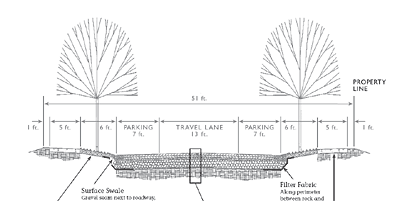On March 26, Pringle Creek in Salem, OR was named Land Development of the Year by the NAHB’s National Green Building Awards. The designation is a new category for the Green Building Awards, and Pringle Creek is the first development to win it.
Pringle Creek is pursuing a full suite of sustainability practices. One of the more experimental is the system of porous streets that capture and purify stormwater runoff. The developers call it an “innovative storm water management system utilizing the largest community porous asphalt and concrete road system in North America.”
Here’s a cross-section of the street design:
Porous pavements have had much promise, but for many years were held back by high failure rates. The EPA (1999) put the historical failure rate at 75%, which was enough to kill any technology. However, better materials, testing, and site design guidelines have dramatically improved performance, to the point where experiments like Pringle Creek make sense.
The magazine Stormwater quotes Bruce Ferguson, author of Porous Pavement:
“There’s a huge potential to restore places that are bearing traffic and acting just like cities, with all the economic and traffic implications,” Ferguson says. On that same “square inch of land,” stormwater infiltration resulting in better groundwater quality and quantity, stream preservation, and tree-root growth could be occurring, he explains. The integration of ecology with urban living “is really a revolutionary way to be building cities.”
Another little-known aspect of roadway ecology is that all cars, even the cleanest full-electric vehicles, shed small amounts of particles and drips from tires, brake pads, body and frame, lubricating oils, cooling fluids, etc. As Ferguson notes, these materials are usually piped into underground water tables or surface water bodies. An alternative is to trap the pollutants in permeable pavement and biofilters.
Metals occur in generic pavements because they get ground out of brake pads and other components. They can get captured in the porous pavement or the soil underneath, Ferguson says. Theoretically, after an extended period, metals could accumulate to toxic levels, he continues. However, metals are either going to accumulate within pavements or at a site downstream. “That’s the only choice we have as long as we keep using automobiles and making them the way we do.”
In a 2006 University of British Columbia technical bulletin, Patrick Condon summarized a study that found this is unlikely to be a major problem:
Finally, while there has been concern that the accumulation of heavy metals and other pollutants in the filtering soils and plant materials of swales, buffers, and underlying materials of permeable pavement could eventually cause the material to be classified as hazardous waste, Barrett et al. found that this is unlikely to be a problem. Their study of vegetated buffer strips along highways found pollutant concentrations in soil samples taken at the end of the two-year study to be low… Since average stormwater runoff contains low pollutant concentrations, even after years of runoff treatment the soil concentrations would be low enough that the removal or disposal of these soils would not have special requirements.
Furthermore, as Condon describes, porous pavements can themselves function as pollution treatment devices.
Results following five additional years of constant use showed that the paving systems and underlying soils were still successfully filtering contaminants from stormwater. For copper and zinc, toxic concentrations were reached in 97% of the [nonporous] asphalt runoff samples, while most infiltrated stormwater samples had concentrations below detectable levels. Motor oil was much lower in the infiltrate than in the surface runoff…
How do these permeable pavements continue to remove pollutants from stormwater over time? Porous pavements actually destroy oil pollutants through the biochemical activity of bacteria and fungi that use the pavement as a substrate. The oils are broken down and disperse safely into the atmosphere as carbon dioxide and water; studies have shown that 97-99% of applied motor oil is trapped in porous pavements and biodegraded.
Still, it’s probably a good idea to continue seeking better solutions. One idea would be to make all vehicular fluids and materials non-toxic. Another would be to improve the ability of pavements to bond with or treat polluting substances. From Stormwater:
Next on the research horizon is development of reactive porous pavements, Sansalone says, which will work reactively through a chemical process to treat the stormwater flow filtering through them. Solute material, such as phosphorous and metals, would have the potential to react with the porous pavement and become immobilized. He says a pilot site for this technology should be running within a year. “If you can take a pavement, which is part of the problem, and modify it to make it part of the solution, that’s really what’s driving our work in porous pavements.”
Since, as Ferguson notes, “Pavements are the most ubiquitous structures built by man,” and cover 2.6 million miles in the U.S. alone, the justification for green streets is clear.
Resources
Pringle Creek community asphalt (video) — the developer of Pringle Creek explains what porous asphalt is and how it works.
Pringle Creek’s Green Street page.
Shallow Stormwater Infiltration Devices vs. Injection Well Systems: a Comparison of Groundwater Contamination Potential, by Patrick Condon (May, 2006). Professor Condon helped create the Sustainable Fairview plan; Pringle Creek is a neighborhood within the Sustainable Fairview plan.
More research bulletins on alternative stormwater management by Patrick Condon.
EPA Storm Water Technology Fact Sheet: Porous Pavement (1999).
Advances in Porous Pavement, Stormwater, March/April 2005.
Porous Pavements, by Bruce K. Ferguson.


Great Work!
One minor thing. I was on the design team for Pringle Creek too, along with Opsis (lead) Ramsay Worden, and Ronald Kellet. Its listed on their web site.
Wonderful article…well done. You rock.
PC
Well, Patrick, I guess we’ve got a mutual admiration society :-)